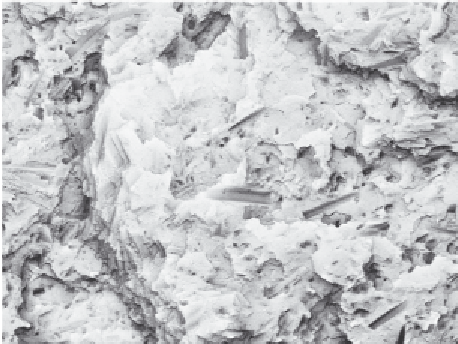Biomedical Engineering Reference
In-Depth Information
11.4 Concluding Remarks
accumulated to form a fatigue crack
[15]
. The
residual elastic modulus and ultimate tensile strength
following fatigue to 1 million cycles was 5
e
30% and
15
e
15%, respectively, for 0
e
30 vol% HA
[15]
.In
four-point bending fatigue, compression-molded
HA-whisker-reinforced PEKK exhibited a fatigue
strength at 2 million cycles of approximately 75, 60,
and 40 MPa for 0, 20, and 40 vol% HA whiskers,
respectively
[27]
.
Figure 11.7
shows a representative
fatigue failure surface of PEKK reinforced with 20
vol% HA whiskers.
Finally, porous PEKK
[29,30]
and PEEK
[31]
scaffolds were prepared by compression molding and
porogen leaching (
Fig. 11.4
) with 75
e
90 vol%
porosity and 0
e
40 vol% HAwhisker reinforcements.
Increased porosity resulted in a nonlinear decrease in
the elastic modulus and yield strength, as expected.
The mechanical properties were generally maximum
and most reliable at 20 vol% HA reinforcement. The
compressive modulus, yield strength, and yield strain
increased with increased mold temperature
[29,31]
to
a maximum at ~375
e
385
C due to improved
densification
[31]
. PEKK scaffolds with 75%
porosity and 20 vol% HA molded at 375
C exhibited
a mean compressive modulus and yield strength of
149 and 2.2 MPa, respectively, which was the highest
of the conditions investigated and similar to human
vertebral trabecular bone (
Table 11.3
). The
mechanical properties of porous calcium phosphate-
reinforced PAEK produced by SLS have not been
reported.
This chapter reviewed key results and accom-
plishments from the first decade of work on bioactive
PAEK composites, and did sowithin the framework of
processing
e
structure
e
property relationships. With
only a little more than one decade of active work
largely centered in three research groups located in
three continents (
Table 11.1
), this chapter is far from
finished. Key processing
e
structure
e
property rela-
tionships in bioactive PAEK composites are only
beginning to be established. Documented research
efforts for bioactive PAEK composites began with one
article published in 1999
[11]
. In 2009, six papers
were published on bioactive PAEK composites.
Therefore, research and development of bioactive
PAEK composites promises to be an active area of
continued growth for the foreseeable future. This
growth will be driven by potential clinical applica-
tions, including permanent implant fixation
(e.g., interbody spinal fusion), synthetic bone graft
substitutes, and fracture fixation hardware (screws,
plates, rods, etc.), among others. Moreover, the
limited supply and risks associated with autograft and
allograft tissue, combined with the cost and recent
scrutiny by the FDA for the use of rhBMP-2 in cervical
spinal fusion
[96]
, should provide ample clinical and
commercial motivation for continued research and
development of bioactive PAEK composites.
Numerous gaps in the current state of knowledge
for bioactive PAEK composites were noted
throughout this chapter. Foremost among these is
a need for in vivo investigations on the osteointe-
gration of bioactive PAEK composites. Continued
materials engineering of processing methods and
microstructures for optimized mechanical properties
should result in dense and porous bioactive PAEK
composites that meet or exceed the mechanical
properties of cortical and cancellous, respectively,
allografts and autografts. A major goal for the next
decade of work should be translation to commercial
products that address clinical needs.
References
10 μm
[1] S.L. Evans, P.J. Gregson, Composite technology
in load-bearing orthopaedic implants, Bioma-
terials 19 (15) (1998) 1329
e
1342.
[2] J.M. Toth, M. Wang, B.T. Estes, J.L. Scifert,
H.B. Seim, A.S. Turner, Polyetheretherketone
Figure 11.7
SEM micrograph showing a representative
failure surface for PEKK (OXPEKK-C) reinforced with 20
vol% HA whiskers after loading in cyclic four-point
bending fatigue. HA whiskers are visible embedded or
protruding from the PEKK matrix.


